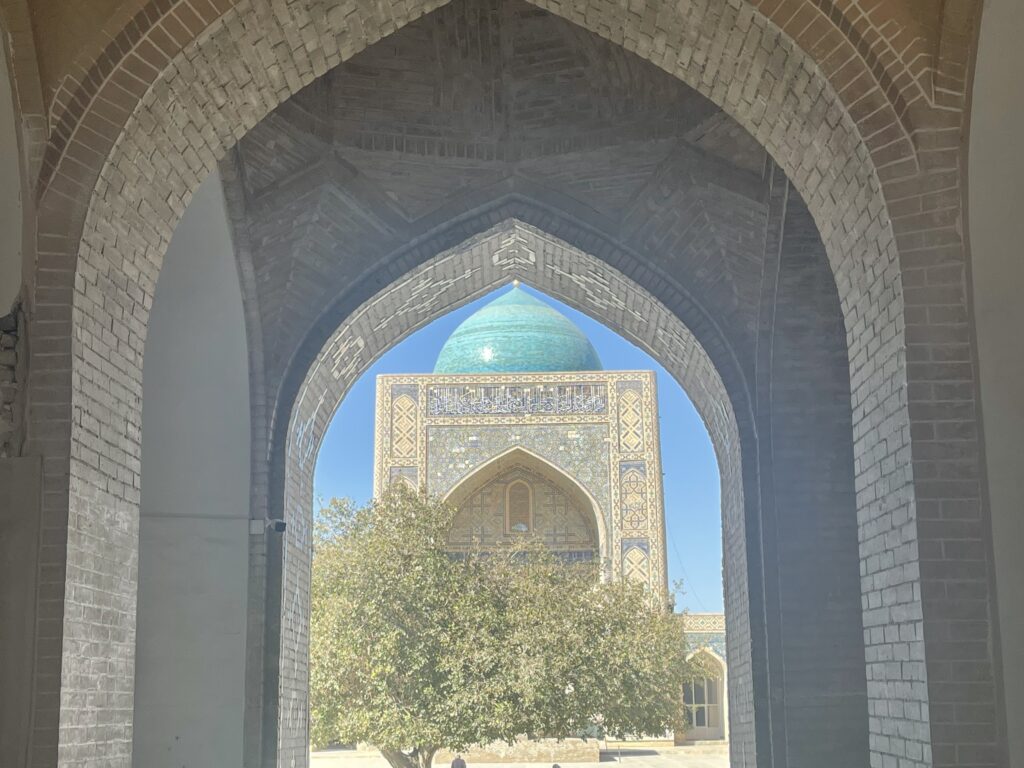Bukhara is one of Uzbekistan’s main cities for tourism and is full of surprises for travelers looking for a lesser known enchanting destination.
We live here in Uzbekistan and we wrote this Bukhara travel guide as it’s our favorite city to visit for a weekend away.
In this article we’ll share with you all the best places to visit, the finest dining options, and the top places to stay in the city.
Disclaimer: This blog post may contain affiliate links. If you make a purchase through these links, I may earn a commission at no extra cost to you. Your support is greatly appreciated and helps me continue to provide valuable content. Thank you!
Bukhara History
Thought have been established somewhere between 2,000 and 2,500 years ago, Bukhara was a major Silk Road trade city which was passed through the hands of the Arabs, the Samanid and Qarakhanid dynasties, before being conquered by Genghis Khan in 1220 and Tamerlane in 1370. It was conquered again by the Uzbek Shaybanids in 1506 who made it the capital of their khanate.
Much of the city was destroyed and rebuilt over the centuries as successive conquerors made their mark on the city. Some of the surviving monuments include the Ismail Samani Mausoleum built in the 10th century and the iconic Kalon Minaret from the 11th century.
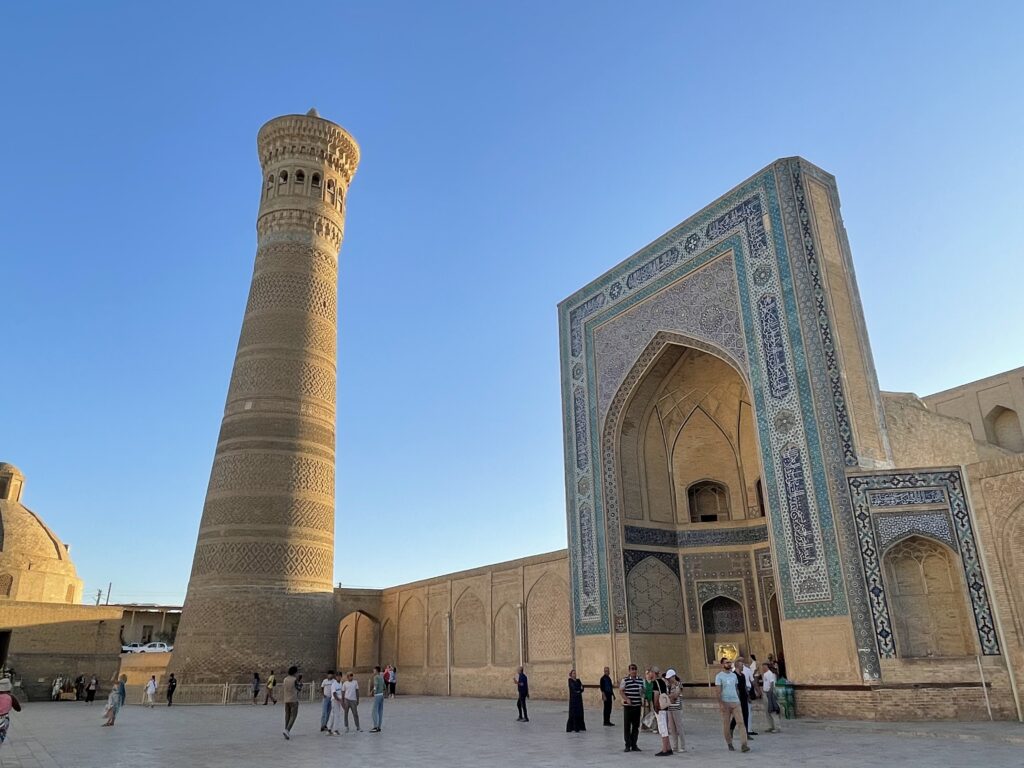
These days most of what remains of the architecture is from the early 16th century Shaybanid dynasty. This includes famous landmarks such as the Lyabi-Khauz ensemble, Poi-Kalyan ensemble, Kosh Medresseh among many others.
Despite becoming a part of the Russian empire in 1868, the Shaybanids would ultimately have the longest lasting influence on Bukhara’s cityscape as the majority of the city’s landmarks come from this period in time.
Bukhara Things To See and Do
According to the president’s own website Bukhara is officially home to 660 cultural heritage sites including “ancient architecture, monumental works of art and archaeological sites”.
There are dozens of landmarks, mosques, madrassas, mausoleums, museums and other places of interest all packed into a relatively small area. Some of the highlights include the Ark of Bukhara, the Chor Minor Madrasah, the Po-i-Kalyan Complex, the Ismail Samani Mausoleum and the Kalon Minaret.
Ark of Bukhara
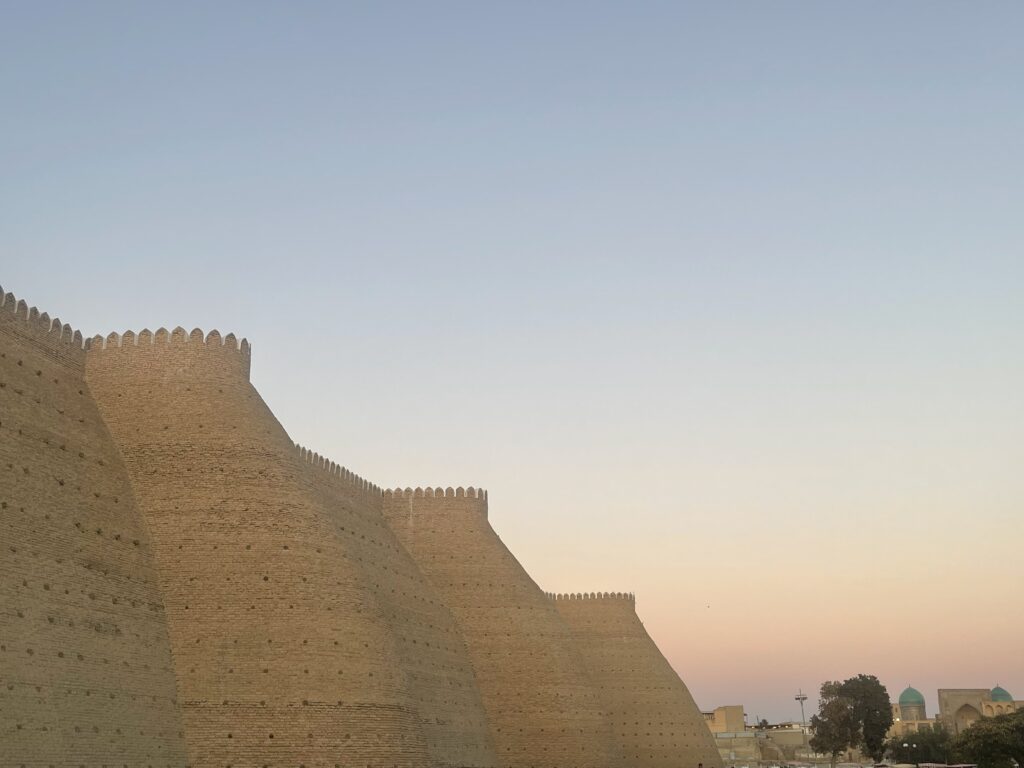
The Ark of Bukhara, a 5th-century fortress and royal residence, stood until 1920 when damaged by the Russian Red Army. The fortress’s external walls have a perimeter of 789 meters, with wall heights ranging from 16 to 20 meters.
Now 80% ruins, the Ark of Bukhara hosts museums, including 17th-century Juma mosque, the living quarters of the former prime minister to the emir, and many historical artifacts. The Ark’s rich history and architecture make it a symbol of resilience and historical significance in Bukhara, Uzbekistan.
Chor Minor
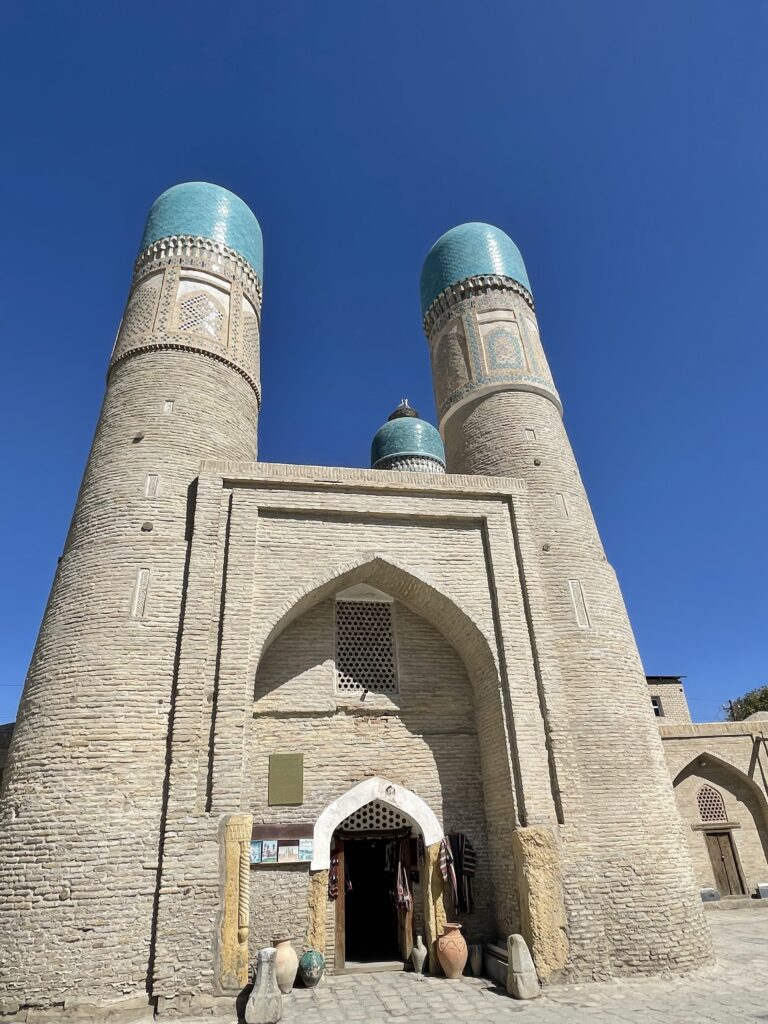
Chor Minor, also known as the Madrasah of Khalif Niyaz-kul, is a historic gatehouse in Bukhara, Uzbekistan. It once served as part of a madrasa complex, built in 1807. The name “Chor Minor” means “four minarets,” referring to its four distinct towers.
The building features a mosque, with a unique interior for Central Asian standards, and rooms for students. Three towers served as storage, while one had a staircase to the top. Each minaret displays different decorative motifs, possibly representing various religions. Today, only the portal, mosque, and minarets remain.
Po-i-Kalyan Complex
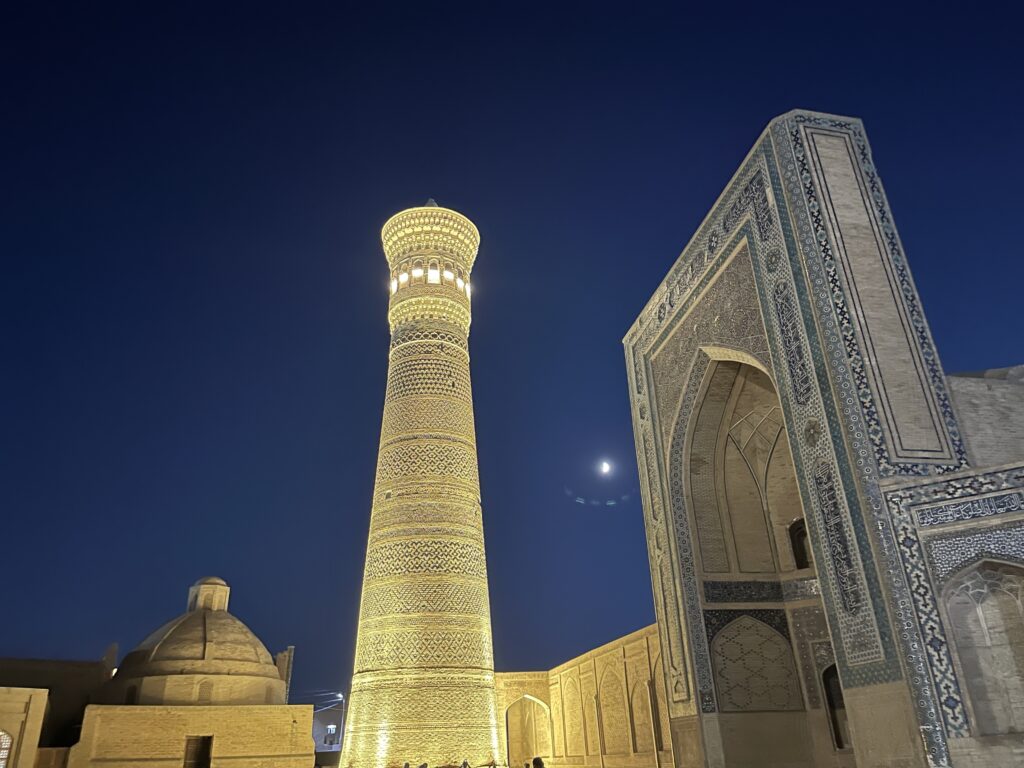
The Po-i-Kalan complex in Bukhara, Uzbekistan, consists of three key elements: the Kalyan Mosque, Kalyan Minaret, and Mir-i-Arab Madrasah. The Kalyan Mosque is one of Central Asia’s largest, featuring a prominent blue dome.
The Kalyan Minaret, built in 1127, stands as an impressive brick structure soaring to a height of 46 meters. Remarkably, it was spared from destruction by Genghis Khan, who was awestruck by its grandeur.
The Mir-i-Arab Madrasah which stands across from the Kalyan Mosque, was founded in 1535 and continues even to this day to serve as a religious educational institution. These architectural components together make the Po-i-Kalyan Complex, showcasing the rich historical and cultural heritage of Bukhara.
Lyabi-Hauz Ensemble
The Lyabi-Hauz Ensemble, translating to “By the pond” in Uzbek, is a historic square in the heart of Bukhara, Uzbekistan.
Once a bustling Silk Road trading post, it has witnessed centuries of commerce and cultural exchange. The ensemble comprises several remarkable structures, including the Nadir Divan Begi Madrassah, featuring intricate mosaics; the Kukeldash Madrassah, one of Bukhara’s largest; and the Khanaka Nadir Divan Begi, a lodge for Sufi Muslims.
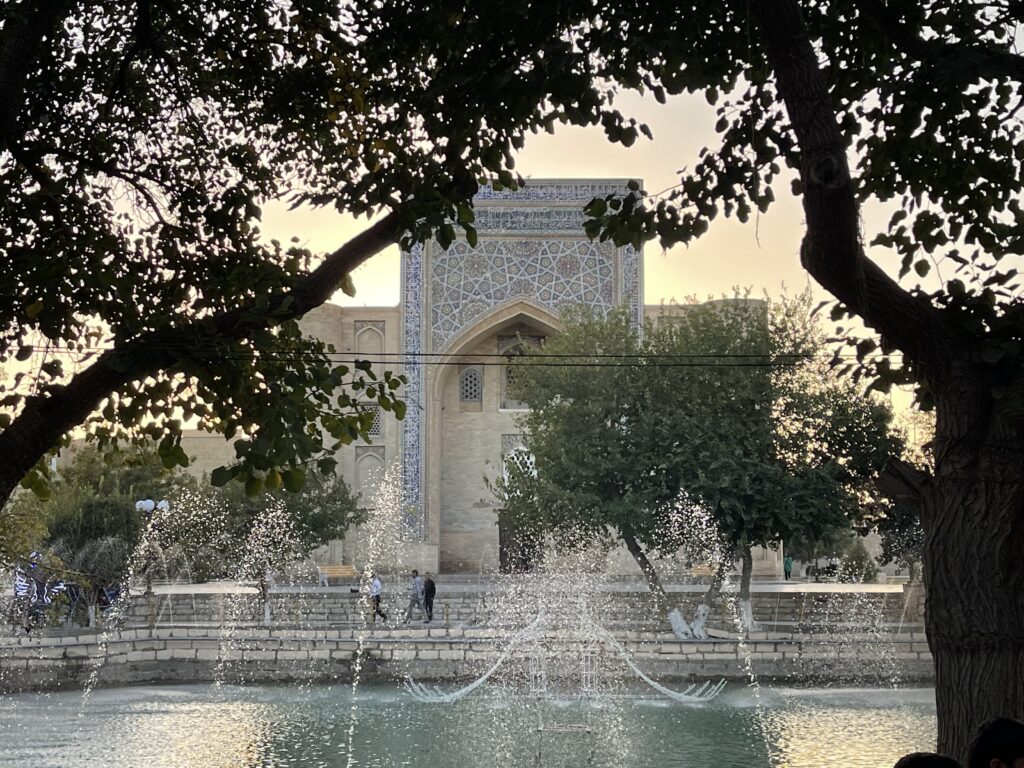
Lesser known things to do in Bukhara include multiple museums such as the Fayzulla Khodjaev Museum and the History of Bukhara Puppet Theater as well as several Uzbek bathhouses known as Hammans.
For those seeking refreshment in the form of tea or coffee and some Uzbek style sweets, the Silk Road Tea House offers a perfect retreat.
For more things to do in Bukhara read our full guide.
Best Time to Visit Bukhara
With a continental climate, Uzbekistan can have quite extreme temperatures during the summer and winter months. With this in mind, the best time to visit Bukhara is in the spring months of March to early June or the autumn months of September and October.
As the peak season for travel, these months will bring more tourists, leading to increased competition for hotels and photo opportunities. However, it’s worth noting that crowds in Uzbekistan’s popular spots are far less dense than in their European counterparts and overcrowding is much less of an issue here.
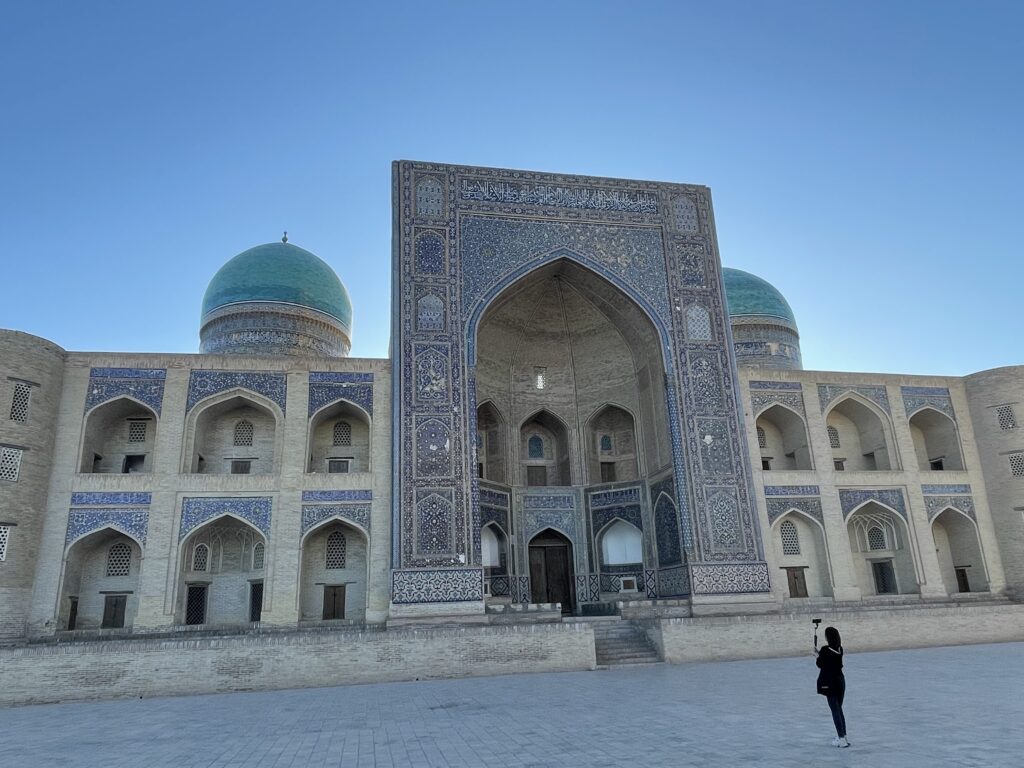
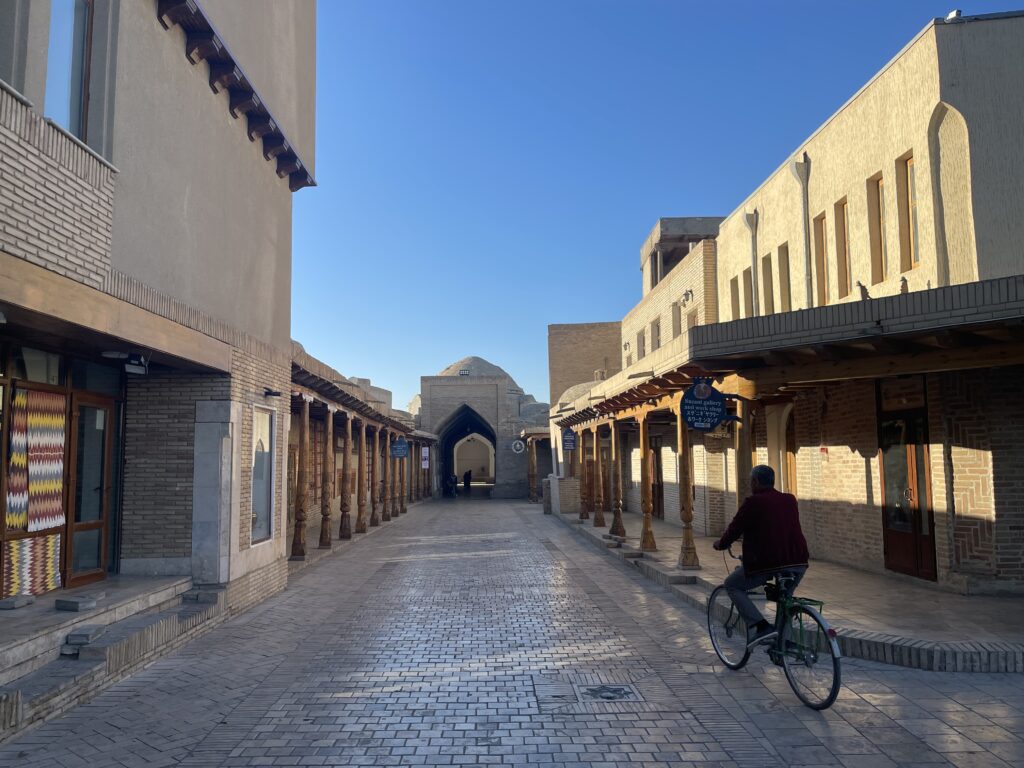
Despite being cooler and occasionally rainy, November can be an excellent time to visit as the lower winter temperatures have not yet started but the tourist spots are almost empty.
National holidays in the Uzbek calendar are:
- New Year (1st January)
- International Women’s day (8th March)
- Navruz Holiday (21st March)
- Memorial Day (9th May)
- Independence Day (1st September)
- Teachers’ Day (1st October)
- Constitution Day (8th December)
- Eid al-Fitr (no fixed date)
- Eid al-Adha (no fixed date)
During the month of Ramadan most restaurants remain open for tourists although day time service may be limited across the city as a whole.
RELATED POST: When to Travel to Uzbekistan
What to Eat in Bukhara
Food in Bukhara is typical of Uzbek food with the most popular meal being plov, the national rice and meat dish. Bukharan plov is similar to Samarkand plov in cooking style but uses a lighter vegetable or sesame oil in its preparation.
Bukhara-style balaza, a variant of Tashkent shurpa, features a hearty mix of beef broth, tender beef chunks, chickpeas, and fennel, and it’s known for its unique cooking method that involves a slow simmer for up to 5 hours.
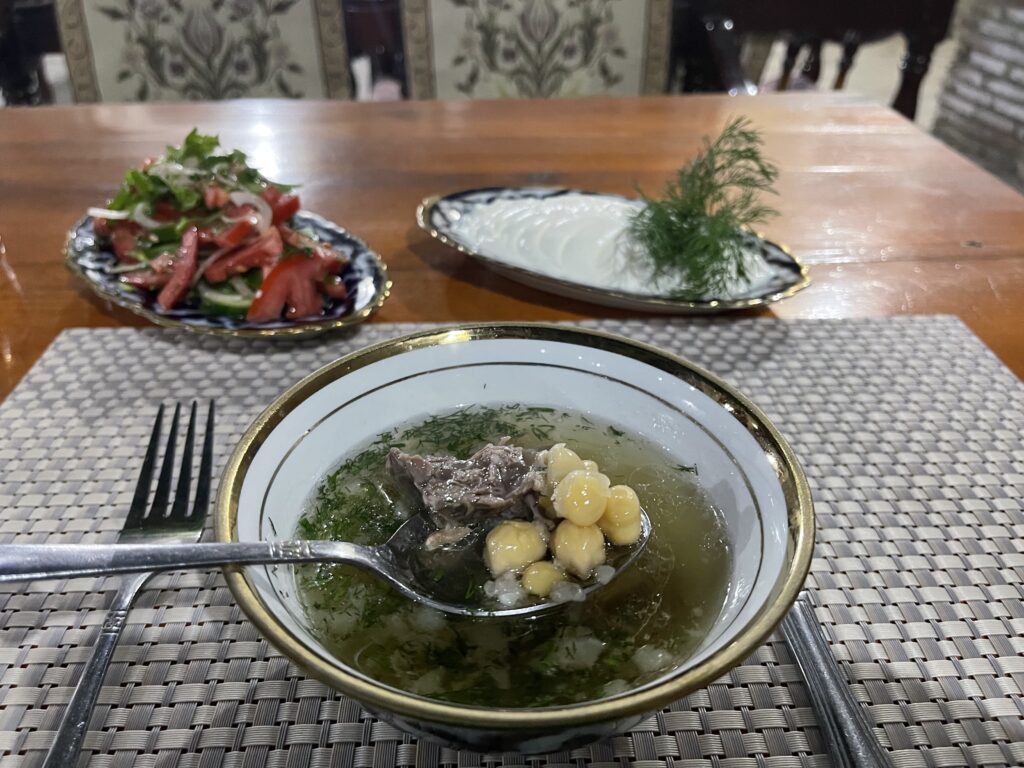
The availability of sweets in Bukhara seems to be higher than elsewhere in Uzbekistan, perhaps due to increased tourism. Bukharan-style halva is frequently chocolate-flavored, while baklava is prepared with honey instead of sugar and features other types of nuts in place of pistachios.
Bukhara has a lot of restaurants aimed mainly at tourists but the quality is quite impressive, especially considering the prices. A filling meal can be bought for as low as 30,000 Som (~$2.50) and even the pricier restaurants are a relative bargain.
Here are our top picks for eating out in Bukhara:
- For Uzbek food in an excellent location try the Lyabi Hauz restaurant next to the Lyabi-Hauz pond.
- To sample some of the best Bukharan plov take a short taxi to ‘The Plov‘ restaurant.
- For something a little fancier head to Ayvan Restaurant in one of the most beautiful restaurants in Uzbekistan.
Read our guide to the top-rated restaurants in Bukhara for more ideas about where to eat.
Once you’ve enjoyed local cuisine there are a surprising number of places to go to enjoy Bukhara nightlife. From quiet beer halls to fancy rooftop bars, there are a number of places to relax in the evening.
Where to Stay in Bukhara
As most of the tourist attractions and many affordable hotels lie within Bukhara old city, it’s advisable to book accommodation close to the center of the old city or at least on one of the backstreets.
Affordable hotels can be found all throughout the old city with most tourist attractions not more than a 20 minute walk.
Some of the best hotels in Bukhara include:
- Marhaba Boutique, rated 9.7
- Oasis Boutique, excellent value for money
- Amulet Hotel, best for comfort
For more information read our guide to the best area to stay in Bukhara.
Is Bukhara Safe?
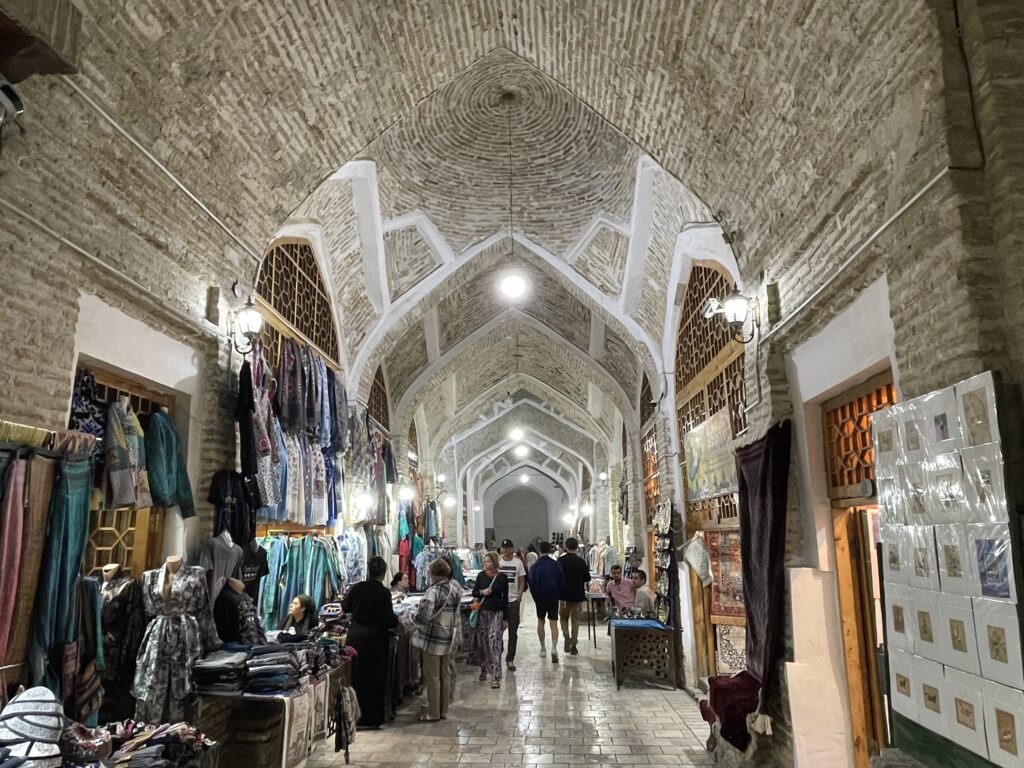
Uzbekistan in general is a very safe country and Bukhara is no different. Rated as a top-tiered country in terms of safety by the US government, crime against foreigners is very rare in Uzbekistan.
As Bukhara’s Old Town is a very tourist-friendly area, you’ll feel very safe here. There are many police officers around and locals are welcoming to foreigners.
From my own experience, I had zero issues regarding safety but take the usual precautions such as keeping your valuables out of sight, avoiding walking alone at night, and being wary of strangers who approach you in the street.
For travel insurance we recommend SafetyWing.
Read our guide to safety in Uzbekistan for more information.
Bukhara Tours
The Old City is very easy to navigate and you can easily stroll around and take in the sights by yourself. If you prefer to have a knowledgeable local guide however consider taking a private tour of the Bukhara.
Bukhara Old City Day Tours
One of the most popular day tours of Bukhara is this Full Day Old City Private Tour.
A fully licensed, knowledgeable guide will take you around all of the city’s main attractions. Stopping off at 14 of city’s hotspots including the Great Minaret of the Kalon, the Ark of Bukhara, Chor Minor, and many more.
Entrance to all attractions is included in the price for this full day tour.
“Our guide, Guzel, was prompt and courteous as she arrived early at our hotel. Our tour was thorough and educational and she afforded us the flexibility for shopping time and a relaxing coffee break which helped make the tour most enjoyable for us.
“She was very knowledgeable about all the history the regional and of course the wonderful architecture. I highly recommend Guzel for your English speaking Bukhara tour guide!” – Brian F
Tour Information:
- Rating: 5.0 ⭐⭐⭐⭐⭐ (31 reviews)
- Length: 5-7 hours (flexible)
- Included: 14 Destinations, Fully licensed guide, Monument Entry Fees
- Not Included: Photography/Video Fees, Tips
Or check our list of best-rated Bukhara tours here.
How to Get to Bukhara
The quickest and most convenient way to reach Bukhara is by plane. However, the most enjoyable mode of transportation is undoubtedly by train as travelers can sit back and enjoy the view of the Uzbek countryside.
By plane: Bukhara has its own airport Bukhara International Airport which is just 4.65km from the center of Bukhara Old City. Flights from Tashkent airport arrive daily and can be booked for as little as $20 if booked in advance.
Book directly at Uzbekistan Airways to see the full schedule of flights. Note that flights to Bukhara from other cities are quite rare.
By train: For a more relaxing and enjoyable method of travel go by train. This is our preferred way to travel to Bukhara as the train has a much more leisurely feel to it.
Bukhara can be reached from Tashkent or Samarkand by Uzbekistan’s Afrasiyab speed train. The journey from Tashkent takes 4 hours and the journey from Samarkand takes 1 hour 40 minutes.
If traveling from Khiva you can take the slower train which usually takes 7 hours.
You can book tickets directly from the official site but tickets often sell out in advance. For guaranteed tickets you can book here instead.
Bukhara train station is just outside of the city and is a 25 minute drive depending on traffic. To get to Bukhara Old City from the train station you’ll need to take a taxi.
If you have a taxi app installed then it should cost you only around 20,000 Som to order a taxi to the center. If not then you’ll need to bargain with a taxi driver who will try to overcharge you. For guaranteed (albeit pricey) pick up you can pre-book train station transfer here.
By Bus: Bukhara can also be visited by bus from Tashkent, Jizzakh, and Navoi. There are buses to Bukhara from Tashkent every two hours. Tickets cost 105,000 Som (~$8-9) but total travel time will be at least 9 hours.
We can’t vouch for this method as we’ve never tried it. It’s slower and less comfortable than the train but can be a good alternative if the trains are sold out. Tickets can be booked online here in English.
By Private Car: Hiring a private car in Uzbekistan is more expensive but might be more affordable than you imagine. For a quote with this get in touch via our contact page.
Frequently Asked Questions
Is Bukhara Worth Visiting?
Bukhara should be on the itinerary of every tourist to Uzbekistan. Although it might not boast the same grandeur as Samarkand, it is a charming city with dozens of smaller historical landmarks hidden within a labyrinth of backstreets. Bukhara is well worth a visit for its history and architecture alone.
How Many Days to Spend in Bukhara?
It’s possible to see much of what Bukhara has to offer in just one day but a two day trip is preferable. With two days you should be able to comfortably visit all of Bukhara’s old city attractions with time to enjoy the city’s gastronomic options.
If you have three days in Bukhara, you’ll also have time to visit some of the lesser visited monuments on the outskirts of the city such as the tranquil Chor Bakr Memorial Complex.
Related post: Bukhara Itinerary for a 1, 2 or 3 day trip.
What Language is Spoken in Bukhara?
The official language of Uzbekistan is Uzbek but in Bukhara you’ll also find many Russian speakers. If staying within the main tourist areas however, you’ll almost always be able to communicate in English.
Learning Uzbek is not necessary but knowing some basic Uzbek phrases will certainly be appreciated. Even basics such as hello (salom) and thank you (rahmat) will go a long way in establishing connections with locals.
If you’re planning a trip to Uzbekistan then don’t miss our complete guide to Uzbekistan travel.
